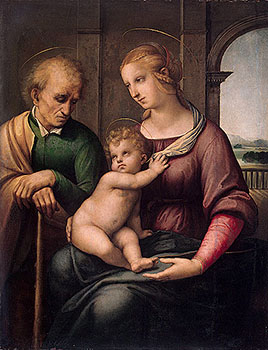HIS 111
Unit 14: Renaissance, Reformation and Exploration
 |
Raphael Santi's The Holy Family (The
Madonna with Beardless Joseph), 1505-06, tempera and oil on canvas. The
Hermitage Museum
in St. Petersburg has one of the finest collections of Renaissance art
in the world. That is largely a legacy of the wealth, power and collecting
prowess of Catherine the Great in the eighteenth century.
|
 What you must do in this unit
What you can do in this unit
Some videos that you can watch for this unit
What you must do in this unit
What you can do in this unit
Some videos that you can watch for this unit
- See the videos dealing with the Renaissance, Reformation and Exploration in the HIS 101 course.
- For extra credit please suggest to your instructor a relevant video for this unit of the course. Send the title of the video, the url and a brief explanation of why you find the video interesting and applicable to the material that is being studied in this unit.
Extra Credit Options
- Take the short 5-point quizzes for chapters 16, 18, 19 and 20. Log into Blackboard and look under "Chapter Quizzes." You have five minutes to complete each quiz (multiple-choice questions).
- For a maximum of 50 points extra credit, read the excerpts from Columbus Journal of his voyages and write a one-page
paper (Do these excerpts provide historians with any useful information
about the native societies of the islands that Columbus reached?)
- In a one-page paper, assess the significance of the
Medici family for Renaissance
Florence for a maximum of 50 points extra credit.
- For a maximum of 25 points extra credit, read the Council of Trent: Rules on Prohibited Books and in a paragraph explain what the Church was attempting to do with these regulations.
- For a maximum of 25 points extra credit, after reading The Discovery of North America by Leif Ericsson, c. 1000
(from The Saga of Eric the Red, 1387), write a paragraph in which you assess whether it really matters who "discovered" American first.
- For a maximum of 25 points extra credit, read the excerpts from Giorgio Vasari (1511-1574), Leonardo da Vinci, and write a long paragraph in which you explain how da Vinci was a perfect expression of the Renaissance ideal.
- Read Luther's
95 Theses and answer the
Luther
study sheet
questions for a maximum of 10 points. Please write in formal, complete sentences.
- For extra credit of a maximum of 10 points,
you can submit the answers to the De Las Casas study questions. Please write in formal, complete sentences.
- For extra credit, please suggest a
relevant website for this unit of the course. Send the title of the site, the url and a
brief explanation why you find the information interesting and applicable to
the material being studied this unit.
|

